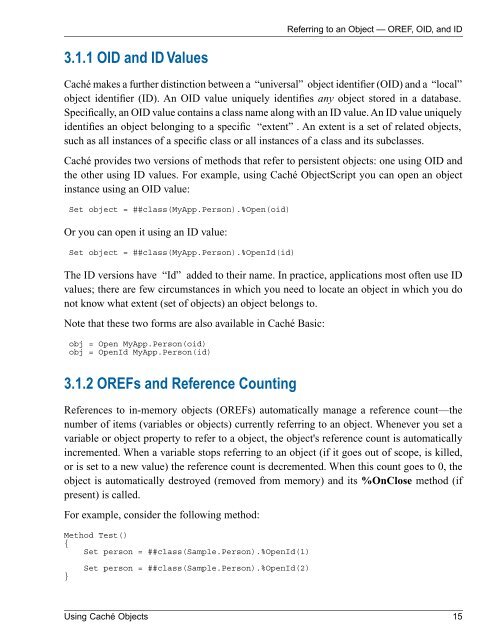Using Caché Objects - InterSystems Documentation
Using Caché Objects - InterSystems Documentation
Using Caché Objects - InterSystems Documentation
You also want an ePaper? Increase the reach of your titles
YUMPU automatically turns print PDFs into web optimized ePapers that Google loves.
Referring to an Object — OREF, OID, and ID<br />
3.1.1 OID and ID Values<br />
<strong>Caché</strong> makes a further distinction between a “universal” object identifier (OID) and a “local”<br />
object identifier (ID). An OID value uniquely identifies any object stored in a database.<br />
Specifically, an OID value contains a class name along with an ID value. An ID value uniquely<br />
identifies an object belonging to a specific “extent” . An extent is a set of related objects,<br />
such as all instances of a specific class or all instances of a class and its subclasses.<br />
<strong>Caché</strong> provides two versions of methods that refer to persistent objects: one using OID and<br />
the other using ID values. For example, using <strong>Caché</strong> ObjectScript you can open an object<br />
instance using an OID value:<br />
Set object = ##class(MyApp.Person).%Open(oid)<br />
Or you can open it using an ID value:<br />
Set object = ##class(MyApp.Person).%OpenId(id)<br />
The ID versions have “Id” added to their name. In practice, applications most often use ID<br />
values; there are few circumstances in which you need to locate an object in which you do<br />
not know what extent (set of objects) an object belongs to.<br />
Note that these two forms are also available in <strong>Caché</strong> Basic:<br />
obj = Open MyApp.Person(oid)<br />
obj = OpenId MyApp.Person(id)<br />
3.1.2 OREFs and Reference Counting<br />
References to in-memory objects (OREFs) automatically manage a reference count—the<br />
number of items (variables or objects) currently referring to an object. Whenever you set a<br />
variable or object property to refer to a object, the object's reference count is automatically<br />
incremented. When a variable stops referring to an object (if it goes out of scope, is killed,<br />
or is set to a new value) the reference count is decremented. When this count goes to 0, the<br />
object is automatically destroyed (removed from memory) and its %OnClose method (if<br />
present) is called.<br />
For example, consider the following method:<br />
Method Test()<br />
{<br />
Set person = ##class(Sample.Person).%OpenId(1)<br />
}<br />
Set person = ##class(Sample.Person).%OpenId(2)<br />
<strong>Using</strong> <strong>Caché</strong> <strong>Objects</strong> 15

















